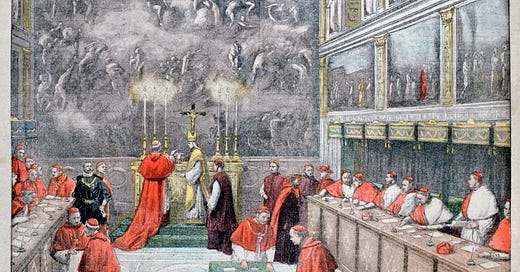One of the fascinating things about a papal conclave is how, the more you dig into how the process works, you discover layers of tradition from the Middle Ages, the Renaissance, and more recent times. For example, let’s start with the question of who exactly chooses the pope. The first historical step toward the papal conclave as we know it today was taken in 1059, when Pope Nicholas II declared that the College of Cardinals would be responsible for electing the pope. Prior to that date, the pope was elected by the clergy of the Diocese of Rome and then submitted to the laity for acclamation. By the ninth century, this latter role was limited to the Roman noble families.
In 1059, however, the right to elect the pope was reserved to the cardinals, although the candidate still needed the acclamation of the clergy of Rome and the laity until the Third Lateran Council abolished this practice in 1179, leaving the selection process entirely to the cardinals. But who were the cardinals? By the early Middle Ages, the most important clergy in Rome had come to be called “cardinals,” derived from its Latin meaning of “principal” or “chief.” The “cardinal bishops” were the bishops of the seven “suburbicarian dioceses,” the dioceses on the outskirts of Rome. The “cardinal priests” were the priests assigned to important churches in Rome and who advised the pope; eventually, some of these priests were assigned as legates who performed diplomatic missions on behalf of the pope. The “cardinal deacons” were the seven deacons assigned to administer charitable works in the diocese on behalf of the pope.
At that time, the College of Cardinals was quite a bit smaller than it is now, with its total number rarely growing beyond thirty. In the fourteenth and fifteenth centuries, there were several efforts to limit the number of cardinals to twenty or twenty-four. The number present for a papal election may have been even smaller; in the Middle Ages, papal elections were held wherever the pope was when he died, and cardinals were given ten days to travel to that location to participate in the election, which meant that some were unable to attend.
The other major contribution of the Middle Ages to the conclave process as we know it is the sequestration of the cardinals. When Pope Clement IV died in 1268, the cardinals gathered in the Italian city of Viterbo, where Clement had resided. The bishops remained deadlocked for months, leading the magistrates of the city to sequester them, limit their diet to bread and water, and eventually to remove the roof of the palace, exposing the cardinals to the elements. Despite these efforts, the cardinals did not elect a pope until 1271, and only then after they had handed the task over to a committee of six of their own. In the meantime, two of the nineteen cardinals present for the election had died!
To prevent a similar lengthy vacancy, in 1274, Pope Gregory X, who had been elected in Viterbo, decreed that in future papal elections, the cardinals should be sequestered from the outside world, with limited access to food (and servants!). After a brief period in which these rules were suspended, Pope Celestine V reinstated them in 1294, and ever since, the sequestration of the cardinals has been a regular feature of the conclaves, although today the cardinals are not limited to bread and water, but rather are provided with simple meals.
Keep reading with a 7-day free trial
Subscribe to Window Light to keep reading this post and get 7 days of free access to the full post archives.




